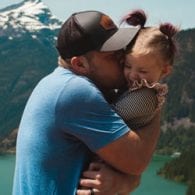Babywearing Dads Help Out Mom
As a father and certified babywearer, I feel that it’s important that a baby gets used to father’s handling too. Father has a different rhythm to his walk; a difference that baby learns to appreciate. The snuggle hold and neck nestle are favorite positions for babywearing dads.
The Neck Nestle
Place the baby in the snuggle position and lift him up a bit until his head nestles into your neck and your neck and chin drape over baby’s head. You will have found one of the most comforting and calming holding patterns. In the neck nestle, babywearing dads have a slight edge over moms. Babies hear not only through their ears but also through the vibration of their skull bones. By placing baby’s head against your voice box, in the front of your neck, and humming and singing to your baby, the slower, more easily felt vibrations of the lower-pitched voice of babywearing dads often lull baby right to sleep. As you rock and walk with your baby, sing a calming song such as “Old Man River.”
Another attraction to the neck nestle is that baby feels the warming air from your nose on her scalp. (Experienced mothers have long known that sometimes just breathing onto baby’s head or face will calm her. They call this “magic breath.”) My babies have enjoyed the neck nestle more than any of the other holding patterns, and I have too. Babywearing dads become a more active shareholder in raising their babies.
The Warm Fuzzy
For a uniquely male variation of the snuggle hold for babywearing dads, place baby’s ear over your heart—bare skin to bare skin. The combination of the rhythm of your heartbeat and movement of your chest, plus the feel of abdominal breathing and the rhythm of your walk, introduce baby to the uniqueness of being worn by dad.
For a father to be comfortable wearing his baby and a baby to respond to dad’s babywearing techniques are real bonuses for mothers of high-need babies. It helps prevent mother burnout. Here is a common scenario a mother of a high- need baby recently shared with me:
I love our new baby, but he is one of those high-need babies that needs to be worn constantly. He was wearing me down, and I was burning out. My husband feels very insecure in calming fussy babies, and for this reason, I was reluctant to release our baby to him during those trying fussy times. The sling was the answer. After my husband got used to wearing our baby, and I saw that our baby liked it, I felt more comfortable releasing our baby to him. Initially, I would hover over my husband to make sure our baby would stop fussing, but as soon as he proved himself a competent babywearer I felt a sense of relief. Even though I wear our baby most of the time, just having my husband share this beautiful experience gives me a much-needed break.
Babywearing Dads Feel Complete
My own experience is similar. I felt a real high the first time I put Stephen in the neck nestle and snuggled him securely against my chest for a walk. As we strolled together, I felt a sense of completeness. Sometimes I wore him for hours at a time. I felt right when we’re together and not right (or complete) when we were apart. These are feelings usually reserved for the mother-infant pair. I wanted a piece of this babywearing action, too. The more I wore Stephen, the more comfortable we both became at trying different wearing positions. The more he liked it, the more I liked it, and the more we enjoyed being together.
Dr.Bill Sears
Dr. Sears, or Dr. Bill as his “little patients” call him, has been advising busy parents on how to raise healthier families for over 40 years. He received his medical training at Harvard Medical School’s Children’s Hospital in Boston and The Hospital for Sick Children in Toronto, the world’s largest children’s hospital, where he was associate ward chief of the newborn intensive care unit before serving as the chief of pediatrics at Toronto Western Hospital, a teaching hospital of the University of Toronto. He has served as a professor of pediatrics at the University of Toronto, University of South Carolina, University of Southern California School of Medicine, and University of California: Irvine. As a father of 8 children, he coached Little League sports for 20 years, and together with his wife Martha has written more than 40 best-selling books and countless articles on nutrition, parenting, and healthy aging. He serves as a health consultant for magazines, TV, radio and other media, and his AskDrSears.com website is one of the most popular health and parenting sites. Dr. Sears has appeared on over 100 television programs, including 20/20, Good Morning America, Oprah, Today, The View, and Dr. Phil, and was featured on the cover of TIME Magazine in May 2012. He is noted for his science-made-simple-and-fun approach to family health.

